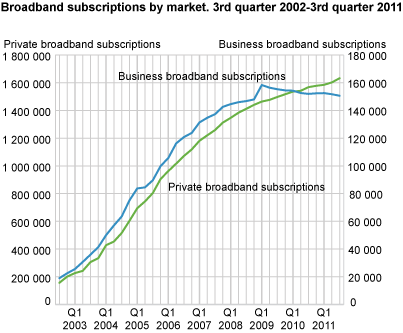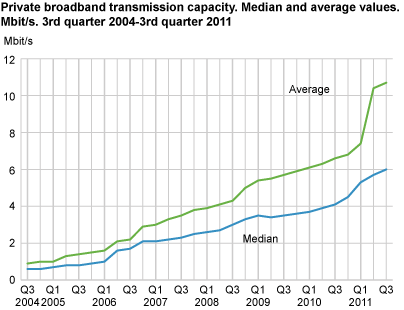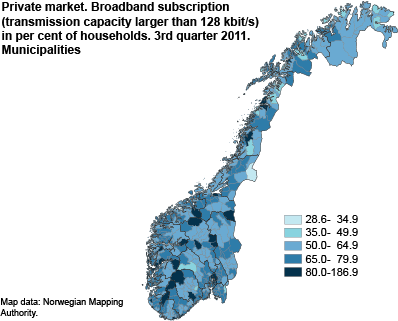Content
Published:
This is an archived release.
Nine out of ten on Svalbard with broadband
On Svalbard, there are 954 private fixed broadband accesses shared between 1 024 households. The penetration rate of 93 per cent is much higher than the 74 per cent on the Norwegian mainland.
The new statistics on numbers of Svalbard households relating to 1 July 2011 have made it possible to calculate the penetration rate of fixed broadband accesses. This high figure is related to the differences in population and household compositions, with very few elderly people living on Svalbard compared to the mainland.
Normal increase in broadband capacity
The average transmission capacity for fixed private broadband has increased to 10.7 from 10.4 Mbit/s in the previous quarter. This means that the rate of change in broadband capacity has returned to normal in the last quarter. At the same time, the median value has increased to 6.0 Mbit/s compared to 5.7 in the previous quarter.
Private broadband subscriptions with a capacity of more than 8 Mbit/s total 38 per cent; an increase from 37 per cent in the previous quarter. Only 21 per cent of business broadband subscriptions have this capacity; an increase from 20 per cent in the previous quarter.
Slow increase in private fixed broadband subscriptions
The number of broadband subscriptions with fixed access on the Norwegian mainland was 1 783 000 at the end of the 3rd quarter of 2011; an increase of 63 000 subscriptions in the last 12 months. Compared to the previous quarter, this is an increase of 29 000 subscriptions. The entire increase in the last quarter relates to private subscriptions. Business subscriptions have fallen by 1 000 during the last year. At the end of the 3rd quarter, Norway had 1 633 000 fixed private broadband subscriptions and 151 000 business subscriptions.
The broadband penetration rate in private households is 74 per cent; an increase from 73 per cent in the previous quarter. Compared to last year there is an increase from 72 per cent. The figure for private broadband subscriptions per 100 households varies between 82 per cent in the county of Oslo and 63 per cent in the county of Finnmark.
| Centrality1 | Broadband subscriptions | Broadband subscriptions as a percentage of households | |||||||||||||||||||||||||||||||||||||||||||||||||||||||||||||||||||||||||||||
|---|---|---|---|---|---|---|---|---|---|---|---|---|---|---|---|---|---|---|---|---|---|---|---|---|---|---|---|---|---|---|---|---|---|---|---|---|---|---|---|---|---|---|---|---|---|---|---|---|---|---|---|---|---|---|---|---|---|---|---|---|---|---|---|---|---|---|---|---|---|---|---|---|---|---|---|---|---|---|---|
| Remote municipalities | 130 339 | 65 | |||||||||||||||||||||||||||||||||||||||||||||||||||||||||||||||||||||||||||||
| Fairly remote municipalities | 90 149 | 70 | |||||||||||||||||||||||||||||||||||||||||||||||||||||||||||||||||||||||||||||
| Fairly central municipalities | 265 879 | 71 | |||||||||||||||||||||||||||||||||||||||||||||||||||||||||||||||||||||||||||||
| Central municipalities | 1 146 088 | 76 | |||||||||||||||||||||||||||||||||||||||||||||||||||||||||||||||||||||||||||||
| 1 | 1 Centrality 2008, Municipalities 2008. |
The most central municipalities have the highest number of broadband subscriptions relative to the number of households. While the number of broadband subscriptions relative to the number of households is 76 per cent, the corresponding figure for less central municipalities is 65 per cent.
| Municipalities | Broadband subscriptions as a percentage of households | ||||||||||||||||||||||||||||||||||||||||||||||||||||||||||||||||||||||||||||||
|---|---|---|---|---|---|---|---|---|---|---|---|---|---|---|---|---|---|---|---|---|---|---|---|---|---|---|---|---|---|---|---|---|---|---|---|---|---|---|---|---|---|---|---|---|---|---|---|---|---|---|---|---|---|---|---|---|---|---|---|---|---|---|---|---|---|---|---|---|---|---|---|---|---|---|---|---|---|---|---|
| Average for all municipalities | 74.2 | ||||||||||||||||||||||||||||||||||||||||||||||||||||||||||||||||||||||||||||||
| 0941 Bykle | 186.9 | ||||||||||||||||||||||||||||||||||||||||||||||||||||||||||||||||||||||||||||||
| 0215 Frogn | 101.2 | ||||||||||||||||||||||||||||||||||||||||||||||||||||||||||||||||||||||||||||||
| 1640 Røros | 96.6 | ||||||||||||||||||||||||||||||||||||||||||||||||||||||||||||||||||||||||||||||
| 1232 Eidfjord | 96.4 | ||||||||||||||||||||||||||||||||||||||||||||||||||||||||||||||||||||||||||||||
| 1046 Sirdal | 96.0 | ||||||||||||||||||||||||||||||||||||||||||||||||||||||||||||||||||||||||||||||
| 0817 Drangedal | 95.1 | ||||||||||||||||||||||||||||||||||||||||||||||||||||||||||||||||||||||||||||||
| 0213 Ski | 91.6 | ||||||||||||||||||||||||||||||||||||||||||||||||||||||||||||||||||||||||||||||
| 1121 Time | 91.3 | ||||||||||||||||||||||||||||||||||||||||||||||||||||||||||||||||||||||||||||||
| 1018 Søgne | 91.2 | ||||||||||||||||||||||||||||||||||||||||||||||||||||||||||||||||||||||||||||||
| 0834 Vinje | 91.1 | ||||||||||||||||||||||||||||||||||||||||||||||||||||||||||||||||||||||||||||||
| 1241 Fusa | 90.6 | ||||||||||||||||||||||||||||||||||||||||||||||||||||||||||||||||||||||||||||||
| 0521 øyer | 90.2 | ||||||||||||||||||||||||||||||||||||||||||||||||||||||||||||||||||||||||||||||
| 0544 øystre Slidre | 89.7 | ||||||||||||||||||||||||||||||||||||||||||||||||||||||||||||||||||||||||||||||
| 1151 Utsira | 89.0 | ||||||||||||||||||||||||||||||||||||||||||||||||||||||||||||||||||||||||||||||
| 0926 Lillesand | 88.5 | ||||||||||||||||||||||||||||||||||||||||||||||||||||||||||||||||||||||||||||||
| 0216 Nesodden | 87.9 | ||||||||||||||||||||||||||||||||||||||||||||||||||||||||||||||||||||||||||||||
| 0230 Lørenskog | 85.8 | ||||||||||||||||||||||||||||||||||||||||||||||||||||||||||||||||||||||||||||||
| 0217 Oppegård | 84.7 | ||||||||||||||||||||||||||||||||||||||||||||||||||||||||||||||||||||||||||||||
| 1601 Trondheim | 84.6 | ||||||||||||||||||||||||||||||||||||||||||||||||||||||||||||||||||||||||||||||
| 1563 Sunndal | 84.6 | ||||||||||||||||||||||||||||||||||||||||||||||||||||||||||||||||||||||||||||||
| 1252 Modalen | 84.2 | ||||||||||||||||||||||||||||||||||||||||||||||||||||||||||||||||||||||||||||||
| 0214 ås | 83.1 | ||||||||||||||||||||||||||||||||||||||||||||||||||||||||||||||||||||||||||||||
| 0219 Bærum | 82.3 | ||||||||||||||||||||||||||||||||||||||||||||||||||||||||||||||||||||||||||||||
|
The mobile broadband access was removed because this part of the statistics is not complete and because these subscriptions cannot be distributed geographically and by download capacity in the same way as the fixed access subscriptions. The Norwegian Post and Telecommunications Authority also compiles statistics on these mobile subscriptions but without information about the geographical location or download capacity. The number of Internet service providers reporting to this survey has been around 200 over the past few years. Market changes have reduced this number to around 180. A few small, but locally important Internet service providers, mostly cable TV providers, are still not included in the survey. Efforts have been made to include these providers. Some small errors related to the distribution of subscribers between municipalities may occur. This can have major consequences for the figures per household for some municipalities. The number of households for 2011 has been used in these statistics. Individuals and businesses can have several Internet subscriptions and several individuals can use the same subscription. The number of subscriptions is therefore not equivalent to the number of households/businesses with Internet access. A household can for instance get Internet access through an employer, educational institution or by sharing access with other households. The survey ICT in households provides more information about households with at least one member under the age of 75 with Internet access. For more information, see About the statistics. |
Tables:
- Table 1 Private broadband subscriptions. Subscription by transmission capacity and county including Svalbard. 3rd quarter of 2011
- Table 2 Business broadband subscriptions. Subscription by transmission capacity and county including Svalbard. 3rd quarter of 2011
- Table 3 Development features. Broadband subscription by market. Active subscriptions only. The whole country without Svalbard
- Table 4 Broadband subscriptions (larger than 128 kbit/s). Business and private subscriptions. 3rd quarter 2011. Municipality
Contact
-
Statistics Norway's Information Centre
E-mail: informasjon@ssb.no
tel.: (+47) 21 09 46 42



